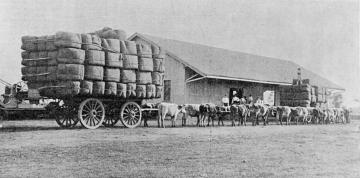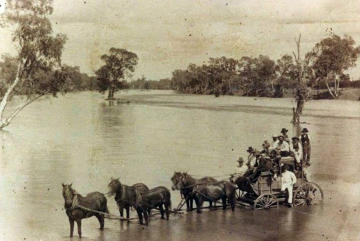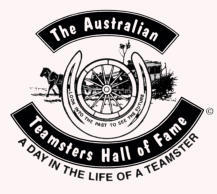
History



The history of the Teamsters and Cobb & Co. is inexorably intermeshed.
It
is
no
stretch
to
imagine
the
connectivity
between
the
indigenous
population,
Bullockies,
Settlers,
Miners,
Black
Smiths, Wheelwrights, Coach Builders and road builders all working together.
The
purpose
of
the
‘The
Australian
Teamsters
Hall
Of
Fame
Museum’
is
to
document
and
tell
the
tale
of
how
Australia
was
opened
up
to
settlers,
how
travel
routes
came
into
being
and
the
story
of
the
men
and
women
that
were the Teamsters.
In
the
beginning
raw
materials
were
required
in
the
form
of
timber
for
construction,
the
‘Bullockies’
were
the
heavy
transport
of
the
day,
hauling
massive
logs
with
teams
of
Bullocks
to
the
saw
mills.
But
how
did
they
find
there
way
around?
Indigenous
tribes
were
in
the
main
nomadic,
this
meaning
they
travelled
the
countryside
following
the
fruiting
seasons
and
other
food
sources.
The
tracks
left
by
these
movements
assisted
the
other
travelers in getting from point A to point B.
Settlers
started
their
push
to
the
north,
loggers
and
bullock
trains
followed
suit
and
them
came
the
gold
diggers.
Bendigo in Victoria and Gympie in South East Queensland being among the most notable gold fields.
A way had to be found to get people from cities to these far flung areas efficiently.
Enter Cobb & Co.
In
1853
two
Americans,
Freeman
Cobb
and
George
Mowton,
were
sent
to
Melbourne
to
set
up
an
international
freight
service
for
their
employer
Adams
Express,
an
American
freight
company
that
had
greatly
profited
from
the
Californian gold rush.
However,
they
soon
found
that
demand
was
not
for
international
freight;
it
was
for
transport
within
the
colony—specifically
to
the
gold
fields.
Melbourne
at
the
time
was
little
more
than
a
frontier
town,
growing
rapidly
and
without
direction.
Disorder
and
lack
of
infrastructure
characterised
the
town.
Roads
were
so
bad
that
Mowton
soon
returned
to
California,
convinced
that
the
difficulties
of
doing
business
in
such
a
place
outweighed
any
opportunity.
Cobb
stayed.
Despite
the
obstacles
presented
by
the
environment
and
the
poor
roads,
he
saw
the
possibilities—thousands
of
people
were
streaming
into
Melbourne
daily,
all
wanting
to
go
north
to
the
gold
fields.
Together
with
John
Peck,
James
Swanton
(who
had
been
sent
to
Melbourne
by
Adams'
competitor
Wells
Fargo)
and
John
Lamber,
they
started
their
own
business
focused
on
passenger
coach
services.
They
called
themselves 'the boys' (their average age was just 22) and ran their new venture in a hands-on way.
Cobb & Co won the right to deliver the Royal Mail, this helped to expand the number of routes and in essence
means that Cobb & Co played a major part in setting up the mail delivery system in Australia.
Cobb
&
Co.
had
to
set
up
every
12-15
miles
or
so
staging
posts
to
rest
the
passengers
and
change
teams
of
horses.
These
staging
posts
were
the
beginning,
in
some
cases,
of
townships
springing
up
along
the
main
routes.
Wheelwrights
were
needed
to
repair
and
make
replacement
wheels.
Black
Smiths
or
‘Smithies’
were
required
to
fix
and
maintain
coaches
and
to
make
the
metal
tyers
the
Wheelwrights
needed
for
the
coach
wheels
and of course horse shoes.
So
it
would
appear
that
Cobb
&
Co.
also
was
responsible
for
creating
jobs,
accommodation
and
a
support
network for it’s business, we owe a lot to this company.
You
will
see
an
original
working
Cobb
&
Co.
Coach
at
the
museum
along
with
artifacts
utilised
by
the
teamsters
to carry out their trades.
Presentations
and
stories
feature
the
characters
that
were
true
pioneers
of
the
area,
the
tools
they
had
at
their
disposal, their food and the way they lived.

The
history
of
the
Teamsters
and
Cobb
&
Co.
is
inexorably
intermeshed.
It
is
no
stretch
to
imagine
the
connectivity
between
the
indigenous
population,
Bullockies,
Settlers,
Miners,
Black
Smiths,
Wheelwrights,
Coach
Builders
and
road
builders
all
working together.
The
purpose
of
the
‘The
Australian
Teamsters
Hall
Of
Fame
Museum’
is
to
document
and
tell
the
tale
of
how
Australia
was
opened
up
to
settlers,
how
travel
routes
came
into
being
and
the
story
of
the
men
and
women
that
were
the
Teamsters.
In
the
beginning
raw
materials
were
required
in
the
form
of
timber
for
construction,
the
‘Bullockies’
were
the
heavy
transport
of
the
day,
hauling
massive
logs
with
teams
of
Bullocks
to
the
saw
mills.
But
how
did
they
find
there
way
around?
Indigenous
tribes
were
in
the
main
nomadic,
this
meaning
they
travelled
the
countryside
following
the
fruiting
seasons
and
other
food
sources.
The
tracks
left
by
these
movements
assisted
the
other
travelers
in
getting
from
point
A to point B.
Settlers
started
their
push
to
the
north,
loggers
and
bullock
trains
followed
suit
and
them
came
the
gold
diggers.
Bendigo
in
Victoria
and
Gympie
in
South
East
Queensland
being
among the most notable gold fields.
A
way
had
to
be
found
to
get
people
from
cities
to
these
far
flung areas efficiently.
Enter Cobb & Co.
In
1853
two
Americans,
Freeman
Cobb
and
George
Mowton,
were
sent
to
Melbourne
to
set
up
an
international
freight
service
for
their
employer
Adams
Express,
an
American
freight
company
that
had
greatly
profited
from
the
Californian
gold rush.
However,
they
soon
found
that
demand
was
not
for
international
freight;
it
was
for
transport
within
the
colony—specifically
to
the
gold
fields.
Melbourne
at
the
time
was
little
more
than
a
frontier
town,
growing
rapidly
and
without
direction.
Disorder
and
lack
of
infrastructure
characterised
the
town.
Roads
were
so
bad
that
Mowton
soon
returned
to
California,
convinced
that
the
difficulties
of
doing business in such a place outweighed any opportunity.
Cobb
stayed.
Despite
the
obstacles
presented
by
the
environment
and
the
poor
roads,
he
saw
the
possibilities—thousands
of
people
were
streaming
into
Melbourne
daily,
all
wanting
to
go
north
to
the
gold
fields.
Together
with
John
Peck,
James
Swanton
(who
had
been
sent
to
Melbourne
by
Adams'
competitor
Wells
Fargo)
and
John
Lamber,
they
started
their
own
business
focused
on
passenger
coach
services.
They
called
themselves
'the
boys'
(their
average
age
was
just
22)
and
ran
their
new
venture
in
a hands-on way.
Cobb
&
Co
won
the
right
to
deliver
the
Royal
Mail,
this
helped to expand the number of routes and in essence
means
that
Cobb
&
Co
played
a
major
part
in
setting
up
the
mail delivery system in Australia.
Cobb
&
Co.
had
to
set
up
every
25
miles
or
so
staging
posts
to
rest
the
passengers
and
change
teams
of
horses.
These
staging
posts
were
the
beginning,
in
some
cases,
of
townships
springing
up
along
the
main
routes.
Wheelwrights
were
needed
to
repair
and
make
replacement
wheels.
Black
Smiths
or
‘Smithies’
were
required
to
fix
and
maintain
coaches
and
to
make
the
metal
tyers
the
Wheelwrights
needed for the coach wheels and of course horse shoes.
So
it
would
appear
that
Cobb
&
Co.
also
was
responsible
for
creating
jobs,
accommodation
and
a
support
network
for
it’s
business, we owe a lot to this company.
You
will
see
an
original
working
Cobb
&
Co.
Coach
at
the
museum
along
with
artifacts
utilised
by
the
teamsters
to
carry
out their trades.
Presentations
and
stories
feature
the
characters
that
were
true
pioneers
of
the
area,
the
tools
they
had
at
their
disposal,
their food and the way they lived.

























